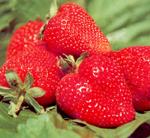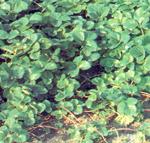| Fruits |
Vegetables
|
Strawberry, Fragaria vesca var. hortensis / Rosaceae
|
Note: Composition for 100 g. of fresh product Values in ( min. - max. ) format. | |
| Energy: 27.00-34.00 kcal Fats: 0.10-0.70 g Fibres: 1.10-1.63 g Minerals Calcium: 16.00-26.00 mgZinc: 0.100-0.269 mg Chlorine: 14.00-18.00 mg Phosporus: 24.00-29.00 mg Iron: 0.40-0.96 mg Magnesium: 10.00-15.00 mg Manganese: 0.225-0.300 mg Potasium: 147.00-160.00 mg Selenium: 1.34-1.34 µg Sodium: 2.50-6.00 mg Iodine: 1.00-9.00 µg | Proteins: 0.80-0.90 kcal Carbohidrates: 5.30-6.00 g Liposoluble Vitamins A Retinol: 2680.00 µgA Carotenoids: 8.00-18.07 µg E or Tocoferol: 0.120-0.200 mg K or Filoquinone: 13.50-13.50 µg Liposoluble Vitamins B1 or Thiamine: 0.030-0.033 mgB2 or Riboflavine: 0.030-0.054 mg B3 or Niacine: 0.60-0.60 mg B5 or Pantothenic Acid: 0.300-0.340 mg B6 or Piridoxine: 0.060-0.060 mg B9 or Folic Acid: 47.00-77.00 mg C or Ascorbic Acid: 47.00-77.00 mg |

The strawberry is a succulent and fragrant fruit of bright red colour, obtained from the plant with the same name. In the West it is considered as the " queen of the fruit". It is eaten raw and used to make jam, stewed fruit... It is also used with medicinal purposes, since it has excellent benefits for health.
Nutrition and eating
Strawberries are highly appreciated for their pleasant aroma and as an appetite stimulator. They are easily digested and they have a great laxative effect, due to their fibre content, pigments, acids and enzymes. It is rich in basic minerals, which confers it the property to stimulate the metabolism.
The fruit
 The strawberry is a succulent and fragrant fruit of bright red colour, obtained from the plant with the same name. In the West it is considered as the " queen of the fruit". It is eaten raw and used to make jam, stewed fruit... It is also used with medicinal purposes, since it has excellent benefits for health.
The strawberry is a succulent and fragrant fruit of bright red colour, obtained from the plant with the same name. In the West it is considered as the " queen of the fruit". It is eaten raw and used to make jam, stewed fruit... It is also used with medicinal purposes, since it has excellent benefits for health.Strawberries (Fragaria vesca) grew spontaneously in the forests. Its culture started quite late, since it is a very fragile fruit; in order to obtain a maximum yield in a whole month harvest, the field needed a permanent dedication.
The edible fruit is commonly known as "etaerio’. It is a false fruit consisting of a receptacle bearing the achenes (seed-like parts), small and of pale colour in the part that was exposed to the shade and a dark reddish colour in the part that has been exposed to the sun. The achenes can be inserted in the flesh, superficial or protuberant. There may be numerous or scarce. The protuberant achenes increase the resistance of the surface, but during washing many of them come off. The consumer normally prefers the fruit with few achenes, since they remain between the teeth when we bite them.
The central part or "heart’ of the fruit may be welll-developed or very little developed, we may also find ‘heartless’ fruits. This is a negative characteristic. The fruits have various shapes, according to the cultivar: conical, conical-elongate, conical-rounded, spheroidal, oblate, reniform (kidney shape).
Strawberries are usually harvested at the beginning of summer. Wild strawberries are generally smaller than the cultivated ones, but they have a better aroma and taste, slightly bittersweet.
Strawberries are low in calories. Their energetic value per 100 g of edible fresh fruit ranges from 27 to 34 kcal. Apart from water, their main component are carbohydrates. Fructose represents practically half of the glucids and the rest is mainly glucose. It has a low percentage of proteins. This berry is an excellent source of vitamin C.
This fruit is easily digested, having a great laxative effect. The contraindications are scarce, only people with stomach pathologies must not eat, since they are quite acid. When this fruit is consumed in jams, it looses many of its nutritious properties.
If the strawberries are mature they are usually eaten raw, with yoghurt or ice cream. They are sprayed with cream or sprinkled with liquor and they are delicious covered with chocolate. Strawberries with the worse appearance are used to prepare cakes, mousses, soufflés, cream caramel and pies.
They must be stored in the fridge or in a fresh, dark and ventilated place. It is not advisable to freeze them, because they loose a great amount of water when they are defrosted: they become a kind of raw jam, without aroma. It is recommended to wash them before their consumption to remove soil or injurious substances.
The plant

Strawberries belong to the genus Fragaria. They are perennial, herbaceous plants, of sawed leaves, that may be soft or hairy.
Their stems are small and short, transformed into a rhizome from which the leaves and crawling stems called runners propagate, producing roots and shoots at the nodes. The stem that grows along the surface of the soil, commonly known as crown, is very short and contains vascular tissues. The stem’s habit can be elongate or erect.
The roots have a fibrous appearance and they arise from the crown next to the surface of the soil. They are divided in primary and secondary roots. The primary roots quickly propagate along the soil, extending approximately 30 cm around the crown and branching obliquely, penetrating around 30 cm deep.
The leaves are subdivided in three folioles with sawed edges. Their thickness varies according to the cultivar and their colour is a more or less intense green, turning into a reddish colour in the winter varieties.
The strawberry flowers are grouped in inflorescences. They can be "perfect" (hermaphrodite) with masculine and feminine organs or " imperfect" (unisexual) only with masculine or feminine organs. Most of the commercially cultivated varieties have perfect flowers.
Each perfect flower has a chalice with 5 sepals, a corolla usually bearing 5 white petals of variable shape (rounded or oval), and multiple masculine organs. The receptacle contains the feminine organs or pistils. Those flowers having all of their pistils fertilized will bear fruits with the typical shape of the cultivar. If the climatic conditions are not the appropriate ones for pollination, a part of the pistils may not be fertilized and therefore fruits obtained will be deformed.
Their stems are small and short, transformed into a rhizome from which the leaves and crawling stems called runners propagate, producing roots and shoots at the nodes. The stem that grows along the surface of the soil, commonly known as crown, is very short and contains vascular tissues. The stem’s habit can be elongate or erect.
The roots have a fibrous appearance and they arise from the crown next to the surface of the soil. They are divided in primary and secondary roots. The primary roots quickly propagate along the soil, extending approximately 30 cm around the crown and branching obliquely, penetrating around 30 cm deep.
The leaves are subdivided in three folioles with sawed edges. Their thickness varies according to the cultivar and their colour is a more or less intense green, turning into a reddish colour in the winter varieties.
The strawberry flowers are grouped in inflorescences. They can be "perfect" (hermaphrodite) with masculine and feminine organs or " imperfect" (unisexual) only with masculine or feminine organs. Most of the commercially cultivated varieties have perfect flowers.
Each perfect flower has a chalice with 5 sepals, a corolla usually bearing 5 white petals of variable shape (rounded or oval), and multiple masculine organs. The receptacle contains the feminine organs or pistils. Those flowers having all of their pistils fertilized will bear fruits with the typical shape of the cultivar. If the climatic conditions are not the appropriate ones for pollination, a part of the pistils may not be fertilized and therefore fruits obtained will be deformed.
| Interempresas Media, S.L. / 2025 | [ Legal notice | Política de Protección de Datos | Política de cookies | Publicidad] |
